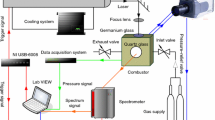Abstract
Boron carbide (B4C) is one of the main products from the primary combustion of boron (B)-based propellants and has a significant influence on the secondary combustion of B. To systematically evaluate its effects on the secondary combustion of B, mixtures of B4C and B in different mass ratios were prepared. To study the ignition temperatures and combustion flames of the samples, a xenon lamp ignition experimental system and a flame shape test system were designed, respectively. A thermogravimetry–differential scanning calorimetry–Fourier transform infrared spectroscopy combined thermal analysis system was used to study the thermal oxidation characteristics and analyze the gaseous products of the samples. The results indicate that B4C reduces the heat absorption at the beginning of the ignition, but subsequently prevents the rapid rise of sample temperature. During the stable combustion stage, the maximum flame length under optical density 10−4 (OD4) filter was 20.4 mm, and the maximum flame length under 580 nm + OD4 filters (represents the combustion of B element) was 16.7 mm. The samples contained a small amount of HBO2 and H3BO3, which led to slight mass loss during the low temperature section of the thermal oxidation process. During the high temperature section, the oxidation of B and B4C caused considerable mass gain. The gaseous products of the thermal oxidation process include CO2, CO, and H2O. In general, the B content of 60% was the most beneficial to decrease the oxidation temperature, increase the combustion intensity, and improve the heat-releasing ability of the samples.















Similar content being viewed by others
References
Perez JPL, McMahon BW, Schneider S, et al. Exploring the structure of nitrogen-rich ionic liquids and their binding to the surface of oxide-free boron nanoparticles. J Phys Chem C. 2013;117(11):5693–707.
Kuwahara T, Obuchi K, Takahashi K, et al. Mass transfer in the recirculation zone of ducted rocket. In: 44th AIAA/ASME/SAE/ASEE joint propulsion conference & exhibit. 2008.
Liu J, Xi J, Yang W, et al. Effect of magnesium on the burning characteristics of boron particles. Acta Astronaut. 2014;96:89–96.
Liu L, He G, Wang Y, et al. Chemical analysis of primary combustion products of boron-based fuel-rich propellants. RSC Adv. 2015;5:101416–26.
Yang W, Ao W, Zhou J, et al. Impacts of particle size and pressure on reactivity of boron oxidation. J Propuls Power. 2013;29(5):1207–13.
Krier H, Burton RL, Spalding MJ, et al. Ignition dynamics of boron particles in a shock tube. J Propuls Power. 1998;14(2):166–72.
Krier H, Burton RL, Pirman SR, et al. Shock initiation of crystalline boron in oxygen and fluorine compounds. J Propuls Power. 1996;12(4):672–9.
Ao W, Wang Y, Li H, et al. Effect of initial oxide layer on ignition and combustion of boron powder. Propellants Explos Pyrotech. 2014;39(2):185–91.
Liang D, Liu J, Xiao J, et al. Energy release properties of amorphous boron and boron-based propellant primary combustion products. Acta Astronaut. 2015;112:182–91.
Liu L, He G, Wang Y. Thermal reaction characteristics of the boron used in the fuel-rich propellant. J Therm Anal Calorim. 2013;114(3):1057–68.
Liu L, He G, Wang Y. Effect of oxidizer on the combustion performance of boron-based fuel-rich propellant. J Propuls Power. 2014;30(2):285–9.
Hsieh WH, Peretz A, Kuo KK, et al. Combustion behavior of boron-based BAMO/NMMO fuel-rich solid propellants. J Propuls Power. 1991;7(4):497–504.
Liu L, He G, Wang Y. Study on the calculation of the combustion products of the boron-based fuel-rich propellant during first combustion stage. Chin J Explos Propellant. 2013;4:46–51.
Liang D, Liu J, Xiao J, et al. Effect of metal additives on the composition and combustion characteristics of primary combustion products of B-based propellants. J Therm Anal Calorim. 2015;122(1):497–508.
Zhang W, Zhu H, Fang D. Research in solid fuel-rich propellant. Chin J Explos Propellants. 2002;25(1):25–8.
Trowbridge JC, Breazeal JD. Coating of boron particles. U.S. Patent 4,915,753. 1990-4-10.
Liang D, Liu J, Zhou J, et al. Combustion characteristics and propulsive performance of boron/ammonium perchlorate mixtures in microtubes. J Energ Mater. 2016;34(3):297–317.
Liu LL, Liu PJ, He GQ. Ignition and combustion characteristics of compound of magnesium and boron. J Therm Anal Calorim. 2015;121(3):1205–12.
Xi J, Liu J, Wang Y, et al. Effect of metal hydrides on the burning characteristics of boron. Thermochim Acta. 2014;597:58–64.
Li SC, Williams FA, Takahashi F. An investigation of combustion of boron suspensions. In: Twenty-second symposium (international) on combustion. The Combustion Institute; 1988. p. 1951–60.
Spalding MJ, Krier H, Burton RL. Boron suboxides measured during ignition and combustion of boron in shocked Ar/F/O2 and Ar/N2/O2 mixtures. Combust Flame. 2000;120(1):200–10.
Yoshida T, Yuasa S. Effect of water vapor on ignition and combustion of boron lumps in an oxygen stream. Proc Combust Inst. 2000;28(2):2735–41.
Li S, Ji R. Composition analysis of combustion residues of metallized solid propellant. J Propuls Technol. 1996;17(1):83–8.
Ao W, Yang W, Wang Y, et al. Ignition and combustion of boron particles at one to ten standard atmosphere. J Propuls Power. 2014;30(3):760–4.
Ao W, Yang W, Wang Y, et al. Study on combustion characteristics and kinetics of boron in different atmosphere. Proc Chin Soc Electr Eng. 2012;32(29):59–65.
Li H, Ao W, Wang Y, et al. Effect of carbon dioxide on the reactivity of the oxidation of boron particles. Propellants Explos Pyrotech. 2014;39(4):617–23.
Han L, Wang Q, Ma Q, et al. Influence of CaO additives on wheat-straw pyrolysis as determined by TG–FTIR analysis. J Anal Appl Pyrol. 2010;88(2):199–206.
Liu PJ, Liu LL, He GQ. Effect of solid oxidizers on the thermal oxidation and combustion performance of amorphous boron. J Therm Anal Calorim. 2016;124(3):1587–93.
Jain A, Anthonysamy S. Oxidation of boron carbide powder. J Therm Anal Calorim. 2015;122(2):1–8.
Acknowledgements
This work was funded by the National Natural Science Foundation of China (No. 51106135).
Author information
Authors and Affiliations
Corresponding author
Rights and permissions
About this article
Cite this article
Liang, D., Liu, J., Li, H. et al. Improving effect of boron carbide on the combustion and thermal oxidation characteristics of amorphous boron. J Therm Anal Calorim 128, 1771–1782 (2017). https://doi.org/10.1007/s10973-016-5989-2
Received:
Accepted:
Published:
Issue Date:
DOI: https://doi.org/10.1007/s10973-016-5989-2




